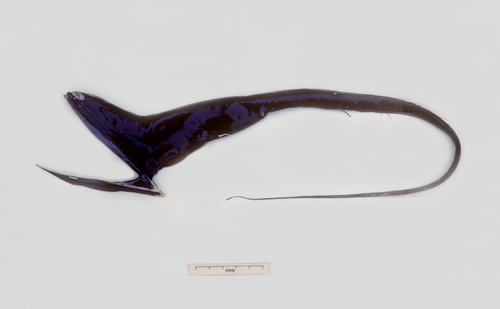
Gulper Eel
The Atlantic bluefin tuna (Thunnus thynnus) is a magnificent and highly migratory species renowned for its size, speed, and commercial value. It plays a crucial role in the marine ecosystem and has been a prized catch for centuries.
Unknown Unknown years
Lifespan
75 cm
Length
Least Concern
Conservation Status
Unknown km/h
Swimming speed
Carnivorous
Diet
Unknown
Migration
Appearance Overview
The Atlantic bluefin tuna is a large, torpedo-shaped fish with a metallic blue-black back and a silvery-white underside.
Coloration
Dark metallic blue on top, silvery-white underside
Fins
Two dorsal fins, the first depressible; small, yellow finlets run down the back and underside
Body Shape
Torpedo-shaped, streamlined for speed
Length
Up to 13 feet (4 meters)
Weight
Up to 2,000 lbs (907 kg)
Diet
Carnivorous, feeding on a variety of fish, squid, crustaceans, and eels.
Feeding Behavior
Highly active predators, they use their speed and agility to hunt, often working cooperatively to herd and capture prey.
Social Behavior
Forms large schools, especially during migrations; exhibits complex social behaviors.
Commercial Relevance
Extremely high value, particularly in the sushi and sashimi markets of Japan; one of the most valuable fish species globally.
Conservation measures
Subject to international fishing quotas, stock management plans, and monitoring; efforts to rebuild depleted populations are ongoing.
Status
Endangered (Varies by region, some stocks are more depleted than others)
Threats
Overfishing (historically and continuing in some areas), illegal fishing, bycatch in other fisheries.
Habitat Distribution
Depth Range
Surface waters to depths of over 3,000 feet (900 meters)
Geographic Range
Widely distributed across the North Atlantic Ocean, including the Mediterranean Sea.
Preferred Environment
Prefers temperate and subtropical waters; highly migratory, often found in open ocean environments.
Reproduction and Life Cycle
Breeding Habits
Spawns in the Mediterranean Sea and the Gulf of Mexico; spawning typically occurs in spring and summer.
Development Stages
Eggs are pelagic (free-floating); larvae develop rapidly, feeding on plankton and growing into juveniles; growth continues at a fast pace.
Fecundity
Females are highly fecund, capable of releasing millions of eggs (up to 30 million) per spawning season.
Maturity Age
Reaches sexual maturity at around 4-8 years of age, although this can vary by location.
Faqs about Gulper Eel
How long do Atlantic bluefin tuna live?
Atlantic bluefin tuna can live up to 40 years.
How fast can Atlantic bluefin tuna swim?
They are among the fastest fish in the ocean, capable of bursts of speed up to 40-60 mph.
Do Atlantic bluefin tuna migrate?
Yes, they undertake long migrations across the Atlantic Ocean for feeding and spawning.
Are Atlantic Bluefin Tuna warm blooded?
They are warm-blooded, which is unusual for fish, allowing them to maintain a higher body temperature than the surrounding water.
What's the biggest Atlantic bluefin tuna ever caught?
The largest recorded Atlantic bluefin tuna weighed around 2,000 lbs.
Why are Atlantic bluefin tuna endangered?
Overfishing has severely depleted their populations, making them a conservation concern.
Why is bluefin tuna so expensive?
Their meat is highly prized for its flavor and texture, especially in sushi and sashimi.
Where do Atlantic bluefin tuna spawn?
They primarily spawn in the Mediterranean Sea and the Gulf of Mexico.
How do bluefin tuna regulate their body temperature?
They have a unique ability to maintain a body temperature higher than the surrounding water, thanks to a specialized circulatory system.
Copyright @ Nature Style Limited. All Rights Reserved.
 English
English